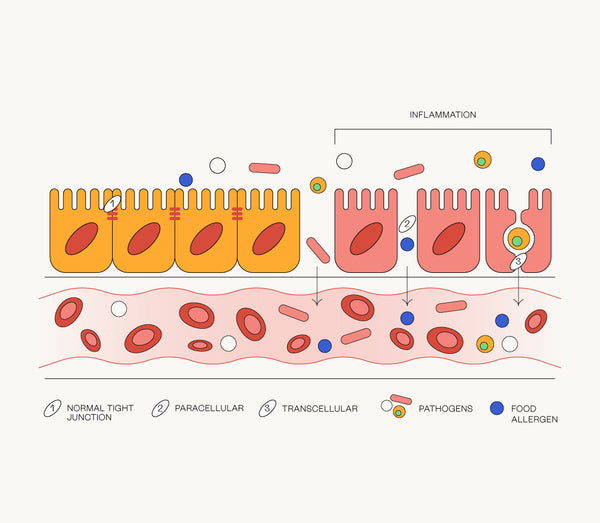You are what you eat. It’s a famous term that most of us have heard at least once in our lifetime but there really is an element of truth in it.
What you eat has a direct impact on the composition and diversity of your gut microbiota. If a scientist looked inside your gut at the bacteria resident there, they could tell exactly the type of diet you’re eating.
No one is going to forensically analyse your colon but in the Western world we are accustomed to a diet that might favour our taste buds rather than our microbial mates.
Animal protein, fats, sugars – all the temping nasties that many of us enjoy daily, are not the favourite food of friendly bacteria. No, instead, they would thank you for squeezing in a bit more fibre.
That’s right, fibre is a truly underestimated food group and through its consumption allows your gut residents to drive, thrive, and survive.
If you’re wondering what fibre is – think food that comes out of the ground i.e., wholegrains, fruit and vegetables. Not all fibre is created equal, though, there are different types.
Want to know more? Let’s unearth the facts…
Human gut microbiome and fibre: a short history
If you could go back in time, you would discover that your ancestors ate around 100g of fibre every day. That’s huge compared to the adequate intake of 14g per day in today’s world – and some people don’t even reach that [10].
Thankfully, we don’t need to go back in time to see the differences in gut microbiomes in hunter-gatherer style populations and more modern, westernised populations. Microbiome research involving the Hazda, an original hunter-gatherer population, uncovered some interesting results.
The diet of the Hazda typically includes five foods; meat, berries, a type of fruit called baobab, tubers, and honey. Because they do not have refrigerators and convenience stores, their diet fluctuates throughout the year depending on what food is available.
Investigating 350 stool samples collected from 188 Hazda individuals, researchers found the gut microbial community varied according to the season coherently with the food available to the tribe. And, in fact, highlighted that some bacterial species can bounce back when specific sources of prebiotics become available [11].
Today, gut microbiome research is gathering pace because the colon could unlock many secrets about human health and disease. Many studies have been carried out in humans and animal subjects. The human microbiome project was launched in 2007 to improve our understanding of the gut and its role in health.
Fibre is boring and brown, isn’t it?
It’s easy to think of fibre as the cardboard-y cereals you see in the breakfast aisle at your local supermarket but it’s so much more than that.
Let’s begin with the basics.
What is fibre?
Dietary fibre is literally the undigested part of plant-based foods. In the past, fibre was like a personal trainer for your colon, literally there to give it a workout – bulking up your poop, making it easier to pass, and keeping your bowel working as it should [1].
Today, it is seen as so much more. Just because the human body is unable to break it down doesn’t just render it a bulking agent. Instead, dietary fibre is a good source of sustenance for your gut microbes, who turn it in to some pretty magical things and enhance host interactions.
First, let’s define the descriptors used to categorise fibre, often based on its solubility [2].
Soluble fibre is the type that dissolves in water to form a gel-like substance. It has many health benefits, including lowering blood glucose levels warding off type 2 diabetes, lowering cholesterol levels to reduce your risk of heart disease, and making you feel fuller for longer – perfect if you’re trying to lose weight or limit snacking.
Soluble fibre food examples, include:
- Apples
- Beans
- Citrus fruits
- Oats
- Peas
- Sweet potatoes
Insoluble fibre is exactly that, insoluble in water. That means it travels through the gastrointestinal tract untouched. It is this type of fibre which helps to bulk out your poop and enables it escape your body more easily.
Insoluble fibre food examples, include:
- Bran
- Bread
- Nuts
- Pasta
- Rice [3]
Resistant starch is a type of starch which is not digested in the small intestine and is a type of fibre. Cleverly, it travels through the small intestine intact and, when it reaches the large intestine, is broken down by the bacterial communities in the gut. They digest it for you and turn it into beneficial metabolites.
Resistant starch is naturally present in:
- Bananas
- Grains
- Potatoes
- Pulses
- Seeds [4, 5].
Does fibre play an important role in my gut microbiome?
Dietary fiber is not just a poop pal, there are some types which help to nourish the good bacteria in your gut. This type is called prebiotic fibre. Don’t forget your gut is home to trillions of microbial residents who, just like you, need to eat to stay alive, thrive, and function properly.
To be considered prebiotic, fibre must:
- Not be digested in the gastrointestinal tract
- Stimulate the growth and/or activity of specific health-promoting bacteria
- Benefit human health [6].
Need to refresh your memory on probiotics? Skip to our Live Cultures 101 knowledge page [LINK].
Although all prebiotics are fibre, not all fibre is prebiotic.
Types of prebiotics
Why doesn’t Innate Co. use FOS?
Fructo-oligosaccharides are a non-digestible carbohydrate which are widely accepted as prebiotics [8]. They are naturally present in many plant-based foods and are used by many different commercial brands in foods, sugar alternatives, and supplements.
However, at Innate Co. we have made the conscious decision to not include FOS into our products because there is some research which suggests FOS may not be so great for you.
Studies show that FOS may worsen the symptoms of IBS [9] and can cause some gastrointestinal side effects in some people, including:
- abdominal cramps
- bloating
Increase Bifidobacteria and Lactobacilli abundance
Prebiotic fibre helps to nourish the natural inhabitants of the gut, Bifidobacteria and Lactobacilli.
Bifidobacteria is one of the first microbes to colonise the gut and is associated with numerous health benefits in humans [12]. Lactobacillus also inhabits the gut from birth, mainly because your mother’s vaginal microbiome largely consists of this genus of bacteria. They also have wide-ranging health benefits.
So, prebiotic fibre helps to nourish these probiotic bacteria in your gut, boosting the microbiome’s diversity and maintaining good health.
SCFA production especially butyrate
When gut microbes ferment carbohydrates as well as other nutrients, they produce short-chain fatty acids or SCFAs in the colon. SCFAs include acetate, propionate, and butyrate. Of particular interest is butyrate, because it has numerous health benefits not least because it is the main source of fuel for the cells that line your colon, called colonocytes.
Prebiotic fibres help to keep the butyrate producers like Faecalibacterium prausnitzii, well nourished. In doing so, their abundance and activity will increase, so more butyrate is produced [6]. Remember, healthy gut = healthy you!
Plug a leaky gut
Remember, your gut has tight junctions which help to form a barrier in the epithelial lining of your gastrointestinal tract.
Well, if these tight junctions become undermined, then they become loose and allow nutrients, metabolites, even pathogens to pass from the gut into the bloodstream.
However, when prebiotic fibre is fermented by gut microbes, there is an increase in the production of SCFAs which help to strengthen the tight junctions and improve the barrier function, lowering inflammation and preventing nasties from free flowing into the body.
Food for thought: where can I get them?
Now you know why your body (and your bacterial best friends) need fibre, here’s a few examples of prebiotic foods:
- apples
- bananas
- barley
- chicory root
- flaxseeds
- garlic
- Jerusalem artichoke
- leeks
- oats
- onions
- wheat bran
Remember, healthy individuals will have a more diverse microbiome and eat a wide range of prebiotic fibre sources.
Synbiotics
So, now you know what prebiotic fibre is and that it can transform the composition of your gut microbiome, you probably can’t wait to get munching.
But prebiotic fibre isn’t only present in food, it’s also added to food supplements, too. At Innate Co. we’ve combined the health benefits of probiotics with the nourishing advantages of prebiotics to bring you a standout daily synbiotic.
Containing 8 probiotic bacterial strains, a combination of Bifidobacteria and Lactobacilli and their genetic material, the addition of prebiotic fibre helps the probiotic bacteria to transform it into some exquisite metabolites, unleashing a whole host of health benefits.
Alongside, a healthy lifestyle, pre and probiotics may help to enhance and support your gut health.
References
[1] O’ Grady, J., O’ Connor. E, M and Shanahan, F. Review article: dietary fibre in the era of microbiome science. Aliment Pharmacol Ther. 49. DOI: 10.1111/apt.15129 (2018)
[2] Gidley, M, J and Yakubov, G, E. Functional categorisation of dietary fibre in foods: Beyond ‘soluble’ vs ‘insoluble’. Trends in Food Science & Technology. https://doi.org/10.1016/j.tifs.2018.12.006 (2018)
[3] Oxford University Hospitals NHS Trust. Information of Fibre. Available at: https://www.ouh.nhs.uk/patient-guide/leaflets/files/11855Pfibre.pdf (2018)
[4] Maier, T, V et al. Impact of dietary resistant starch on the human gut microbiome, metaproteome, and metabolome. mBio, 8. doi: 10.1128/mBio.01343-17 (2017)
[5] British Nutrition Foundation. Resistant Starch. Available at: https://www.nutrition.org.uk/nutritionscience/nutrients-food-and-ingredients/resistant-starch.html (2021)
[6] Carlson, J, L et al. Health Effects and Sources of Prebiotic Dietary Fiber. Current Development in Nutrition, 2. doi: 10.1093/cdn/nzy005 (2018)
[7] Davani-Davari, D et al. Prebiotics: definition: types, sources, mechanisms, and clinical applications. Foods, 8. doi: 10.3390/foods8030092 (2019)
[8] Lockyer, S and Stanner, S. Prebiotics – an added benefit of some fibre types. Nutrition Bulletin, 44. DOI: 10.1111/nbu.12366 (2019)
[9] Hayes, P, A., Fraher, M, H and Quigley, E, M, M. Irritable bowel syndrome: The role of food in pathogenesis and management. Gastroenterology & Hepatology, 10. (2014)
[10] Garcίa-Meseguer, M, J., Delicado-Soria, A and Serrano-Urrea, R. Fiber patterns in young adults living in different environments (USA, Spain, and Tunisia). Anthropometric and lifestyle characteristics. Nutrients, 9. doi: 10.3390/nu9091030 (2017)
[11] Goldman, B. Hunter gatherers’ seasonal gut-microbe diversity loss echoes our permanent one. Available at: https://www.eurekalert.org/pub_releases/2017-08/sumc-hsg082117.php (2017)
[12] O’Callaghan, A and van Sinderen, D. Bifidobacteria and their role as members of the human gut microbiota. Frontiers in Microbiology, 7. doi: 10.3389/fmicb.2016.00925 (2016)


